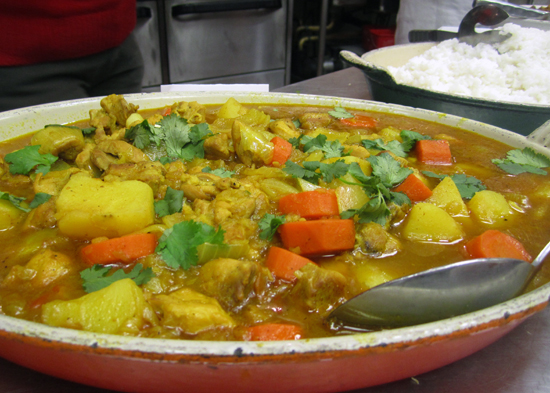What is it that unequivocally defines something as a curry? I’ve asked Indian friends, I’ve asked American friends who lived in India and I’ve spent tireless hours at the hole-in-wall restaurants of Manhattan’s “Curry Hill” district investigating for myself, but every answer is different. So, I entered ICE’s World of Curries class curious to see how Chef Dan Stone would define curry. While the answer wasn’t definitive, it was certainly interesting.
Part of why curry is so hard to define is that, thanks to centuries of colonization, the dish has found its way to numerous corners of the globe. Over the course of four hours, the students in the class and I made our way through five different curries from five different countries ranging from India and Thailand, to Japan and and the Caribbean, each with a different but distinct technique and flavor profile. Added to the menu were various chutneys as well as three different types of rice side dishes. Here are some of the best tips from a class about this indefinable dish:
Spice so Nice: The only central component of curry is curry paste or curry powder, but even these have various flavor profiles that are totally dependent on the country, the region and the individual cook. The curry blend traditionally used in southern India includes turmeric, coriander, cayenne pepper, cumin and black pepper, though fenugreek, mustard seeds, curry leaves, cinnamon and cloves can all be added at your discretion.
Something’s Fishy: As with almost any Southeast Asian cuisine, the ingredient of choice to add a little salt to a curry paste is fish sauce. Though it has a strong smell when standing alone, it blends nicely into the other ingredients used to make curry paste. While that is noble to strive to make your own, it’s usually much more efficient to just by a high-quality curry paste from your local Asian grocer. If you do decide to make your own paste, add fresh paste at a two-to-one ratio for recipes that call for store-bought since fresh paste is much less concentrated.

For Your Little Helper: Most curry recipes call for galangal. This root-spice is closely related to ginger. In fact, you can easily substitute with ginger if you have trouble finding it. When using ginger the easiest way to peel it is with an ordinary metal teaspoon, which makes it a great job for kids just learning to cook in the kitchen!
Growing Pains: When cooking rice, no two grains are the same. There are a plethora of ways to grow different types of rice. Some are grown in flooded patties, while others are grown on dry terrain that is only flooded for harvesting. The different growing environments dictate the proper way to cook that particular variety of rice. While a definitive answer to what constitutes a curry still eludes me, I certainly learned a lot, and ate very well along the way!



